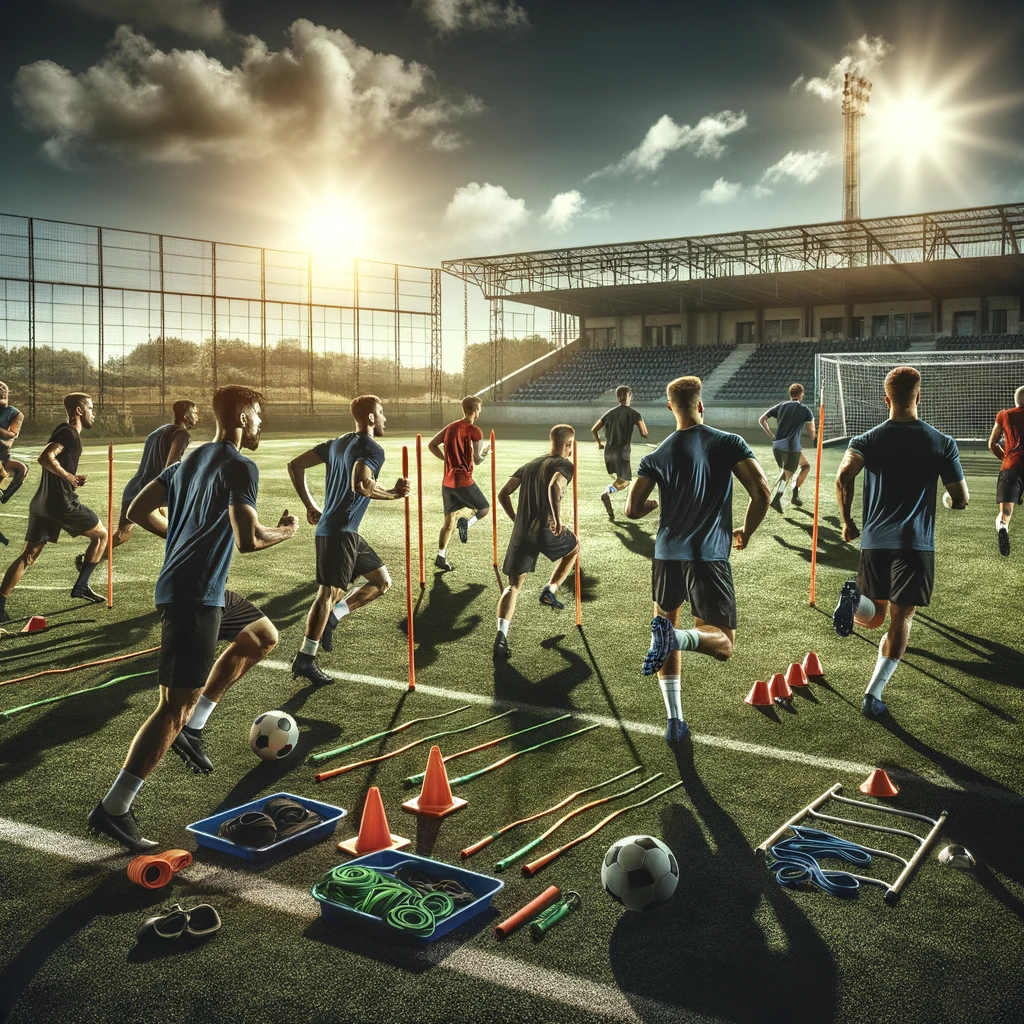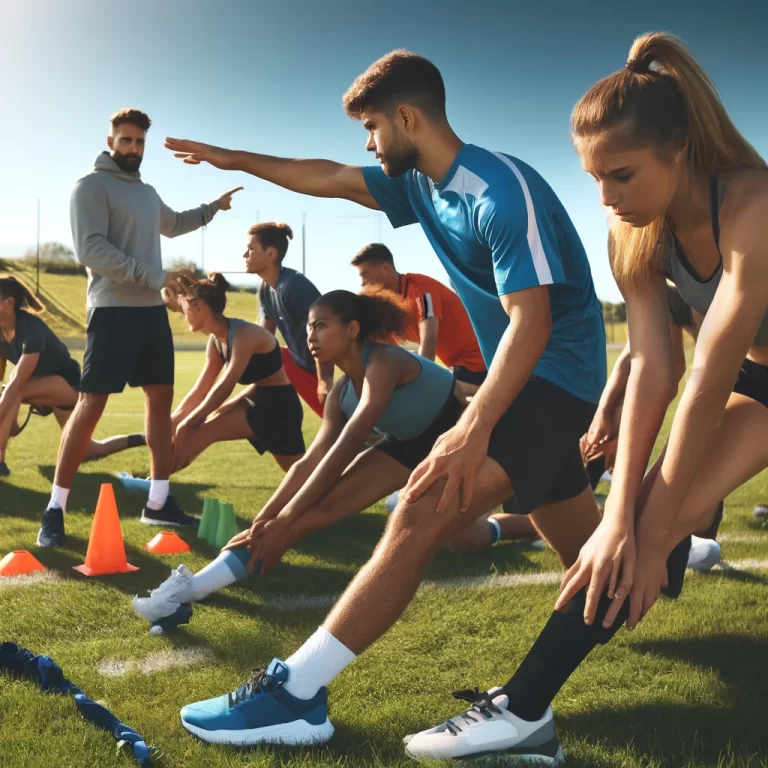Physical Preparation in Football: Elevating the Game with Efficient Methods and Techniques
In the world of soccer, where every detail can be the difference between victory and defeat, physical preparation takes on a leading role.
But what does it really mean to be physically prepared to face 90 minutes of play, beyond the extra time and, sometimes, the dreaded penalties?
Let's dive into this universe together and discover how physical preparation in football has become a great ally for athletes and coaches who seek excellence.
Browse the content

Physical Preparation in Football: What Does It Encompass?
When we talk about physical preparation in football, we are referring to a broad set of practices that aim to improve players' physical conditioning, preparing them not only for the demands of games but for the entire season.
This preparation goes far beyond running around the field or doing some strength exercises. It is a science that encompasses physical assessment, nutrition, recovery and, of course, injury prevention.
Just imagine: each player is a unique universe, with their own strengths, weaknesses and specific needs. Physical preparation in football, therefore, needs to be highly personalized. It starts with a detailed physical assessment, which tells us exactly where the player is and where he needs to go in terms of fitness.
The Relationship Between Physical Preparation and Performance
Have you ever stopped to think about the direct impact that physical preparation has on a player's performance on the field? A physically well-prepared player is able to run more, fight for the ball until the last minutes and, most importantly, significantly reduce the risk of injuries. But fitness in football isn't just about running faster or longer; It's also about playing better.
Let's take the example of resistance. In modern football, it is not enough to have the stamina to last 90 minutes; It is necessary to maintain technical quality and make the right decisions until the final whistle. This means that physical preparation needs to work hand in hand with technique and tactics, in training that is as cerebral as it is physical.
The Main Objectives of Physical Preparation
At each stage of the season, physical preparation in football has different objectives. In pre-season, the focus is on building a solid base of physical conditioning that will sustain the player over the coming months.
During the season, the objective changes to maintaining this condition, with specific adjustments to maximize performance and minimize the risk of injury. And finally, in the postseason, recovery and physical rehabilitation come to the fore, ensuring that the player can return even stronger.
Fitness in football is a journey that never really ends. It is a continuous cycle of assessment, training, recovery and improvement. And, throughout this article, we will explore each of these stages, unveiling the methods and techniques that are transforming the way players prepare for the challenge that is, each football match.
Physical Assessment: The First Step to Efficient Training
Imagine starting a trip without a map or GPS. Sounds like a challenge, right? In football, the physical assessment of players is this map, a crucial tool that directs training in the right direction. This initial, often underestimated step is what allows athletic trainers to create personalized training programs that meet each athlete's specific needs.
Why Evaluate?
Without a detailed physical assessment, we are basically training in the dark. Each player has their own set of strengths, weaknesses and injury risks. Physical assessment in football not only helps identify these elements but also provides valuable data that can be used to optimize individual and team performance as a whole.
The Most Common Tests
In the world of physical preparation in football, there are several methods to assess the condition of players. Some of the most common include:
• Speed and Agility Tests: Measure the player's speed and ability to change direction efficiently.
• Endurance Tests: Assess the player's ability to maintain a high level of performance throughout the game.
• Strength and Flexibility Tests: Essential to determine the player's muscular capacity and range of movement, helping to prevent injuries.
Interpreting the Data
With the data in hand, physical trainers can develop training programs that not only aim to improve areas of weakness but also enhance the player's already strong skills. This customization is key to effective training, reducing the risk of injury and improving performance on the field.
Physical Training Methods: Building High Performance Athletes
After the assessment phase, we get to the heart of physical preparation in football: physical training. Here, art meets science, creating a program that not only prepares players for the demands of the game but also protects them from injury. Let's explore some of the most effective techniques and methods used to prepare high-performance athletes.
Strengthening and Injury Prevention
A key aspect of physical training is muscle strengthening, especially in areas prone to football injuries such as knees and ankles. Strength exercises not only increase players' power and endurance but are also crucial for preventing injuries.
A training program that includes specific exercises to strengthen your muscles and joints can mean the difference between a successful season and one marred by injury.
Endurance: The Fuel of the Game
The ability to maintain a high-intensity performance throughout the game is one of the pillars of physical preparation in football. Resistance training methods, such as high-intensity interval training (HIIT) and continuous aerobic training, are key to developing players' cardiovascular and muscular endurance.
This preparation ensures that athletes can not only run further and for longer but also maintain technical quality and decision clarity until the last whistle.
Speed and Agility: The Key to Explosion on the Field
In football, moments of pure speed and agility can define the outcome of a match. Whether it's sprinting past a defender or the ability to change direction quickly to avoid a tackle, explosiveness is vital.
Training focused on short sprints, footwork and agility exercises help improve these capabilities. The use of agility ladders, cones and barriers encourages players to improve their reaction speed and their ability to execute quick changes of direction, essential for dribbling past opponents and creating scoring opportunities.
Nutrition and Hydration: The Body's Fuel
We cannot talk about physical preparation without touching on the crucial point of nutrition and hydration. A balanced diet and adequate hydration are as important as the physical training itself. Football players need a diet that supports intense training regimes and helps with muscle recovery.
Carbs for energy, proteins for muscle repair, and healthy fats for inflammation are key. Furthermore, correct hydration before, during and after games and training keeps performance at its peak and prevents injuries and cramps.
Recovery: Time is Your Ally
Recovery is a crucial step in football fitness that is often overlooked. Methods such as cryotherapy, massages, yoga and Pilates sessions, and active rest are essential to help muscles recover effectively.
A good night's sleep is also incredibly powerful, giving your body the time it needs to repair and strengthen itself. Incorporating recovery days and relaxation techniques into the training program ensures players are always in their best physical and mental state.
Technology and Innovation: The New Frontier
Finally, technology and innovation have played an increasingly important role in football fitness. Wearables that monitor heart rate, distance traveled, speed and even sleep are helping fitness coaches further personalize training regimens.
Real-time data analysis allows for immediate adjustments to training programs, maximizing the effectiveness of each session. These innovations are revolutionizing the way players are prepared, promising an even brighter future for the world of football.
Conclusion: An Endless Journey
Fitness in football is a continuous journey of growth, adaptation and improvement. From initial assessment to incorporating cutting-edge technologies, each step is crucial to developing players who not only shine on the field but also maintain their health and well-being.
Football, with its unique demands, demands a holistic approach that encompasses physical training, nutrition, recovery and technology. This way, athletes can reach the peak of their performance and, more importantly, stay there. And at the end of the day, it is this tireless dedication to physical preparation that turns good players into football legends.






